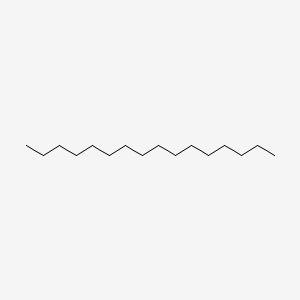| MeSH term | MeSH ID | Detail |
|---|---|---|
| Lupus Erythematosus, Systemic | D008180 | 43 associated lipids |
| Body Weight | D001835 | 333 associated lipids |
| Coronary Disease | D003327 | 70 associated lipids |
| Peritonitis | D010538 | 38 associated lipids |
| Hyperplasia | D006965 | 34 associated lipids |
| Glomerulonephritis | D005921 | 35 associated lipids |
| Encephalomyelitis, Autoimmune, Experimental | D004681 | 26 associated lipids |
| Keratosis | D007642 | 9 associated lipids |
| Serratia Infections | D016868 | 2 associated lipids |
Hexadecane
Hexadecane is a lipid of Fatty Acyls (FA) class. The involved functions are known as Analyte. The related lipids are Fatty Acids and palmitoleic acid.
Cross Reference
Introduction
To understand associated biological information of Hexadecane, we collected biological information of abnormalities, associated pathways, cellular/molecular locations, biological functions, related genes/proteins, lipids and common seen animal/experimental models with organized paragraphs from literatures.
What diseases are associated with Hexadecane?
There are no associated biomedical information in the current reference collection.
Possible diseases from mapped MeSH terms on references
We collected disease MeSH terms mapped to the references associated with Hexadecane
PubChem Associated disorders and diseases
What pathways are associated with Hexadecane
There are no associated biomedical information in the current reference collection.
PubChem Biomolecular Interactions and Pathways
Link to PubChem Biomolecular Interactions and PathwaysWhat cellular locations are associated with Hexadecane?
There are no associated biomedical information in the current reference collection.
What functions are associated with Hexadecane?
Related references are published most in these journals:
| Function | Cross reference | Weighted score | Related literatures |
|---|
What lipids are associated with Hexadecane?
Related references are published most in these journals:
| Lipid concept | Cross reference | Weighted score | Related literatures |
|---|
What genes are associated with Hexadecane?
There are no associated biomedical information in the current reference collection.
What common seen animal models are associated with Hexadecane?
There are no associated biomedical information in the current reference collection.
NCBI Entrez Crosslinks
All references with Hexadecane
Download all related citations| Authors | Title | Published | Journal | PubMed Link |
|---|---|---|---|---|
| Eid M et al. | Exploring the membrane mechanism of the bioactive peptaibol ampullosporin a using lipid monolayers and supported biomimetic membranes. | 2010 | J Biophys | pmid:21403824 |
| Yeom SH et al. | Estimating the cellular maintenance coefficient and its use in the design of two-phase partitioning bioscrubbers. | 2010 | Bioprocess Biosyst Eng | pmid:19915871 |
| van Rooijen BD et al. | Membrane Permeabilization by Oligomeric α-Synuclein: In Search of the Mechanism. | 2010 | PLoS ONE | pmid:21179192 |
| Barreto RV et al. | New approach for petroleum hydrocarbon degradation using bacterial spores entrapped in chitosan beads. | 2010 | Bioresour. Technol. | pmid:19945281 |
| Matsumura H et al. | Unusual effects of triacylglycerol on the reduction of ammonia gas emission during thermophilic composting. | 2010 | Bioresour. Technol. | pmid:19945862 |
| Kornhauser A et al. | Applications of hydroxy acids: classification, mechanisms, and photoactivity. | 2010 | Clin Cosmet Investig Dermatol | pmid:21437068 |
| Martincek I et al. | Volume fraction determination of binary liquid mixtures by measurement of the equalization wavelength. | 2010 | Sensors (Basel) | pmid:22163591 |
| Pyroh TP et al. | [Peculiarities of surface-active trehalose mycolates synthesis of Rhodococcus erythropolis EK-1]. | 2010 Mar-Apr | Mikrobiol. Z. | pmid:20455436 |
| Yeom SH et al. | A strategic approach for the design and operation of two-phase partitioning bioscrubbers for the treatment of volatile organic compounds. | 2010 Nov-Dec | Biotechnol. Prog. | pmid:20718037 |
| Pirog TP et al. | [Intensification of surfactant synthesis in Rhodococcus erythropolis EK-1 cultivated on hexadecane]. | 2010 Nov-Dec | Prikl. Biokhim. Mikrobiol. | pmid:21261075 |
